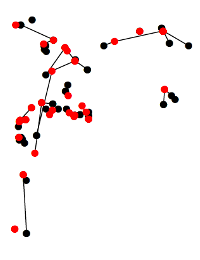A few thoughts from almost 20 yrs of contact tracing another deadly virus @rabidbites 1/n
Even with modern tech (that I’m hopeful for), contact tracing comes down to manual detective work, mostly finding deadends for every contact ID’d. Tracing is laborious & takes time. But time is of the essence (more so with pre/asympt transmission) 2/n http://www.pnas.org/content/101/16/6146">https://www.pnas.org/content/1...
Variation in individuals’ contacts demands agile capacity & effective comms built into system. Makes contact tracing challenging to manage (‘cluster busting’ comes naturally with manual tracing -tech should help) But messaging perhaps more expedient 3/n https://www.sciencemag.org/news/2020/05/why-do-some-covid-19-patients-infect-many-others-whereas-most-don-t-spread-virus-all">https://www.sciencemag.org/news/2020...
Across communities too: R may be <1 in population, but >1 in some communities. Makes emerging from lockdown challenging (a community with no detected infections does not equate to herd immunity. When transmission low, chance is a big factor, as is connectivity) 4/n
In midst of outbreak, contact tracing is incredibly intensive. Keeping up is a struggle. Contact tracing is feasible and most usefully informs real-time response, when circulating cases are low i.e. during the endgame when we want to extinguish the last embers of infection 5/n
Aside: genomics adds value here (eg http://www.nature.com/articles/nature19790).">https://www.nature.com/articles/... We have never had such a richly sequenced virus ( http://www.cogconsortium.uk"> http://www.cogconsortium.uk at least in some countries). During endgame more cases will be ‘orphaned’. Genomics can ID origins, detect cryptic transmission & inform progress
Contact tracing harder in dense urban settings, where more chains of transmission become harder to follow. As clusters become large, with multiple overlapping case generations, IDing who infected whom is more difficult -but those details may not be essential for the response 6/n
During tracing, when a contact found, they may not be willing/able to comply with advice even for a deadly virus (we need to understand why!). Community leaders & local health personnel are crucial to effective tracing, supporting adherence, building trust & responsibility 7/n
Rapid test results (feedback while tracing) greatly improves trust & uptake of recommendations. But testing only poss if cases reached in time. Guidance informed by test results (or syndromic diagnosis) also needs careful personalized delivery to limit misinterpretation 8/n
Tracers need to be able to provide support - advice on what to do & practical assistance how (advice alone can be useless). They can be a lifeline. Tracers need to be prepared for fragility, recently bereaved etc. Process can be emotionally v difficult. Cannot be rushed 9/n
Contact tracing feeds directly to real-time sit reps to coordinate response at local & regional levels. Stats in reports nuanced, hard to translate (incidence, R etc) & don’t have influence of personal stories. Tracing gives rich relatable stories 10/n http://theconversation.com/rabies-a-global-killer-that-dog-jabs-can-eliminate-32289">https://theconversation.com/rabies-a-...
Communities respond strongly when deaths occur locally, but as visible evidence (in the most dramatic form, deaths) recede control measures inevitably relax. Virus may come straight back - this is the key risk facing countries that have been most successful so far 11/n
Even when contained locally (R<1), without herd immunity (from vax) virus can easily return from neighbouring areas without control - coordination needed across administrative boundaries. Tracing informs local & central govts, but their leadership needed to target resources 12/n
Even when contact tracing is exhaustive, not all contacts/ sources of infection can be found. That is the nature of contact tracing & why it is not a magic solution used on its own 13/n
Even 100% effective vaccines (still long way off) only as useful as their delivery - which means knowing local contexts and reaching hard-to-reach communities. A worry given current antivax & antigov sentiments 14/n
Contact tracing is an incredible tool, but much groundwork is needed to get us to where it can be deployed effectively. It cannot be used alone. Trained personnel, diagnostics, local knowledge, trust, communications and hopefully at some point vaccines will all be crucial /end

 Read on Twitter
Read on Twitter




